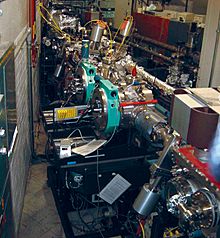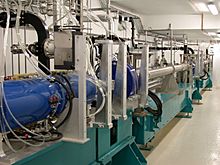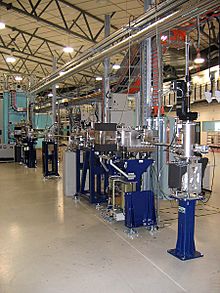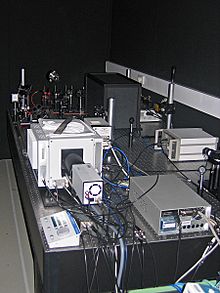Beamline facts for kids

In particle physics, a beamline is the path in a particle accelerator of the particles.
In materials science, physics, chemistry, and molecular biology a beamline leads to the experimental endstation utilizing particle beams from a particle accelerator, synchrotron light obtained from a synchrotron, or neutrons from a spallation source or research reactor.
Contents
Beamline in a particle accelerator

In particle accelerators the beamline is usually housed in a tunnel and/or underground, cased inside a cement housing. The beamline is usually cylindrical metal. Typical names include, beam pipe, and/or a blank section called a drift tube. This entire section must be under a good vacuum in order to have a the beam travel for a long distance.
A survey and alignment crew carefully align the beamline segments by using a laser tracker. All beamlines must be within micrometre tolerance. Good alignment helps to prevent beam loss, and beam from colliding with the pipe walls, which creates secondary emissions and/or radiation.
Synchrotron radiation beamline
Regarding synchrotrons, a beamline is the instrumentation that carries beams of synchrotron radiation to an experimental end station, which uses the radiation produced by the bending magnets and insertion devices in the storage ring of a synchrotron light source. A typical application for this kind of beamline is crystallography. Scientists also use synchrotron light in many other ways.
A large synchrotron laboratory will have many beamlines, each optimized for a particular field of research. The differences will depend on the type of insertion device (which, in turn, determines the intensity and spectral distribution of the radiation); the beam conditioning equipment; and the experimental end station. A typical beamline at a modern synchrotron will be 25 to 100 m (82 ft to 328 ft) long from the storage ring to the end station, and may cost up to millions of US dollars. For this reason, a synchrotron facility is often built in stages, with the first few beamlines at the start of operation, and other beamlines being added later as the funding permits.
The beamline elements are in radiation shielding enclosures, called hutches, which are the size of a small room (cabin). A typical beamline consists of two hutches, an optical hutch for the beam conditioning elements and an experimental hutch, which houses the experiment. Between hutches, the beam travels in a transport tube. People are not allowed to enter hutches when the beam shutter is open and radiation can enter the hutch. Hutches have complex safety systems with redundant interlocking functions to make sure that no one is inside the hutch when the radiation is turned on. The safety system will also shut down the radiation beam if the door to the hutch is accidentally opened when the beam is on. In this case, the beam is turned off by dumping the electron beam circulating in the synchrotron. So, opening one door will shut down all of the beamlines in the facility.
Experimenters use the following elements that are used in beamlines for conditioning the radiation beam between the storage ring and the end station:
- Windows - thin sheets of metal, often beryllium, which transmit almost all of the beam, but protect the vacuum within the storage ring from contamination
- Slits - which control the physical width of the beam and its angular spread
- Focusing mirrors - one or more mirrors, which may be flat, bent-flat, or toroidal, which helps to collimate (focus) the beam
- Monochromators - devices based on diffraction by crystals which select particular wavelength bands and absorb other wavelengths, and which are sometimes tunable to varying wavelengths, and sometimes fixed to a particular wavelength
- Spacing tubes - vacuum maintaining tubes which provide the proper space between optical elements, and shield any scattered radiation
- Sample stages - for mounting and manipulating the sample under study and subjecting it to various external conditions, such a varying temperature, pressure etc.
- Radiation detectors - for measuring the radiation which has interacted with the sample
The combination of beam conditioning devices controls the thermal load (heating caused by the beam) at the end station; the spectrum of radiation incident at the end station; and the focus or collimation of the beam. Devices along the beamline which absorb significant power from the beam may need to be actively cooled by water, or liquid nitrogen. The entire length of a beamline is normally kept under ultra high vacuum conditions.
Neutron beamline
An experimental end station in a neutron facility is called a neutron beamline. Superficially, neutron beamlines differ from synchrotron radiation beamlines mostly by the fact that they use neutrons from a research reactor or a spallation source instead of photons. The experiments usually measure neutron scattering from the sample under study.
Related pages
- Accelerator physics
- Cyclotron
- Ion beam
- Category:Neutron facilities
- Klystron
- Particle accelerator
- Particle beam
- Particle physics
- Quadrupole magnet
- Waveguide




